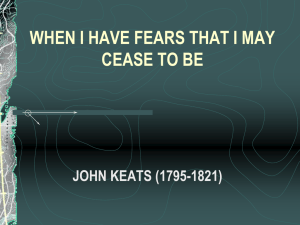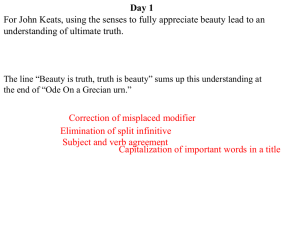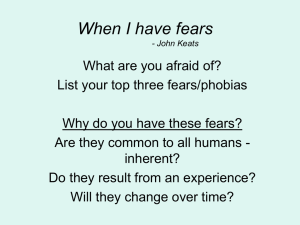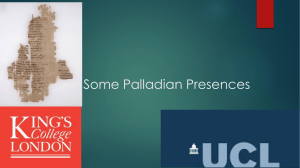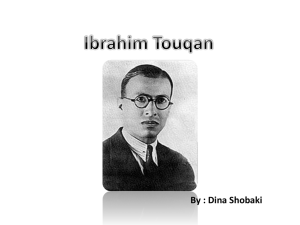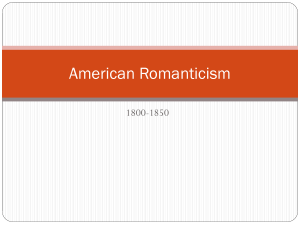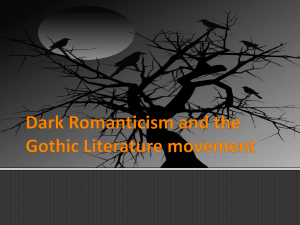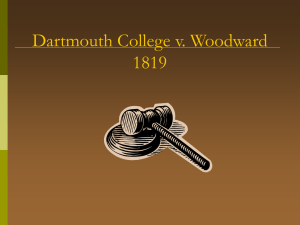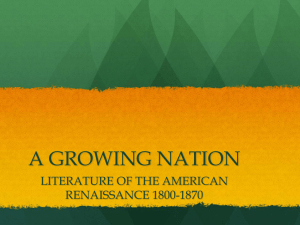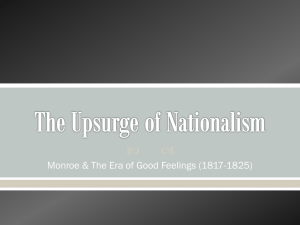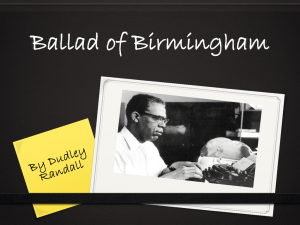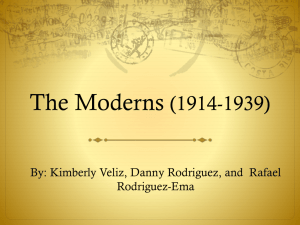John Keats 1795-1821
advertisement
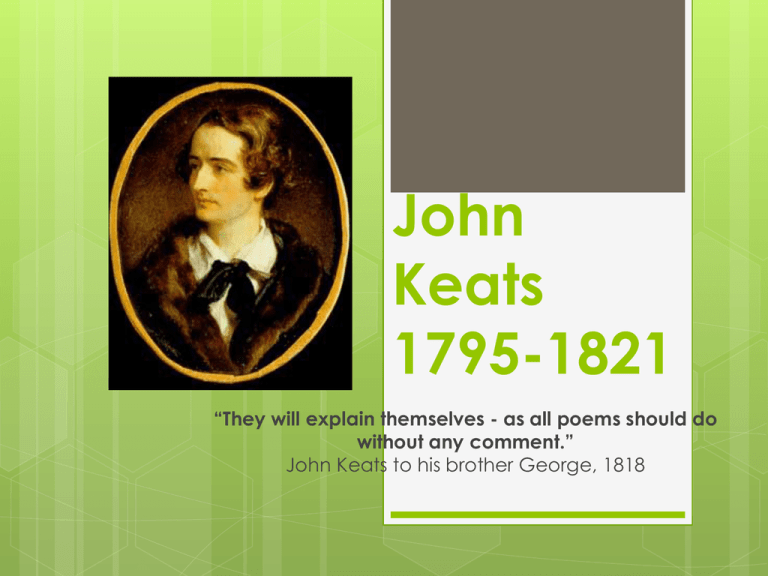
John Keats 1795-1821 “They will explain themselves - as all poems should do without any comment.” John Keats to his brother George, 1818 Early Life Born October 31, 1795 in central London Swan and Hoop Inn Eldest of four children (three boys and one sister, Fanny) Father dies when Keats is eight years old; mother dies of tuberculosis when he is fourteen Keats becomes a key figure in the second generation of the British Romantic movement (along with Lord Byron and Percy Bysshe Shelley) Education & Apprenticeship 1803: parents sent him to board at John Clarke’s school in Enfield, close to his grandparents’ house (financial concerns) Clarke’s school was small, but progressive. Befriended headmaster’s son, Charles Cowden Clarke, who would later introduce Keats to Renaissance literature and serve as a mentor. Volatile, “always in extremes” personality At age 13, Keats began focusing his energy toward reading and studying. At 14, after his mother dies, Keats leaves Clarke’s school to apprentice with Thomas Hammond, a surgeon and apothecary until 1813. Registers as a medical student at Guy’s Hospital in October 1815—shows distinct talent. 1816—receives apothecary’s license, but by the end of the year announces his intention to become a poet, not a surgeon. Suffered periods of depression First poem, “An Imitation of Spenser”, was written in 1814, when Keats was 19 and studying medicine. Early Poetry and Influence Clarke introduces Keats to Leigh Hunt, an influential poet and close friend of Byron and Shelley. Though his poetry was not well received initially, Hunt continued introducing Keats to prominent men, establishing Keats as a respected public figure. 1817—his health failing, Keats moves in with his brothers to help care for brother Tom, who has tuberculosis. Some biographers suggest that it is while nursing his brother that Keats first contracted his “family disease.” Hampstead Heath After brother Tom dies in December 1818, Keats moves in with a friend, Charles Armitage Brown. During the winter of 1818-1819, Keats produces his most mature work. Meets Wordsworth at a dinner at Hampstead. Composes five of his six “great odes” in April and May 1819. Romantic Life (Fanny Brawne Keats first met Fanny Brawne sometime between September and November 1818, when he was nursing his brother Tom. and Isabella Jones) Fanny’s grandfather had kept an inn, as Keats’s father had, and she had also lost several family members to tuberculosis. Their relationship was intimate, but brief. Isabella Jones and Keats were also briefly involved in the winter of 1818-1819, when Keats was at his creative best. Biographers suggest that the first version of Keats’s “Bright Star” sonnet may have been written for Isabella, but the final version was presented to Fanny. He continued to work on this poem until the last months of his life, and the poem is ultimately associated with Fanny. By the end of June 1819, Keats arrived at an understanding with Fanny, though it was not a formal engagement because he still had no financial stability or prospects. Keats suffered knowing that as a struggling poet, he would not be able to marry her anytime soon. He became jealous and depressed. Fanny Brawne "My love has made me selfish. I cannot exist without you — I am forgetful of every thing but seeing you again — my Life seems to stop there — I see no further. You have absorb'd me. I have a sensation at the present moment as though I was dissolving — I should be exquisitely miserable without the hope of soon seeing you. [...] I have been astonished that Men could die Martyrs for religion — I have shudder'd at it — I shudder no more — I could be martyr'd for my Religion — Love is my religion — I could die for that — I could die for you." (Letter, 13 October 1819) Letters Keats wrote hundreds of letters to his brothers, sister, friends, and romantic interests. Much of what we know of Keats, his life, and his inspiration come from his letters. None of Fanny Brawne’s letters to Keats survive. We have his letters to her, but upon his request, after his death her letters were destroyed. Though first published in 1848 and 1878, Keats’s letters were ignored until the twentieth century, when T. S. Eliot described them as "certainly the most notable and most important ever written by any English poet.” Later Life By the end of 1819, tuberculosis took hold and his doctors advised him to move to a warmer climate. September 1820: Keats departs for Rome and dies there five months later. His friend and travel companion, Joseph Severn, nurses him and attempts to comfort him throughout treatment until Keats dies on February 23, 1821 at the age of 25. Keats is buried in Rome. His last request was to be placed under a unnamed tombstone which contained only the words (in pentameter, of course), "Here lies one whose name was writ in water." “This Grave / contains all that was Mortal / of a / Young English Poet / Who / on his Death Bed, in the Bitterness of his Heart / at the Malicious Power of his Enemies / Desired / these Words to be / engraven on his Tomb Stone: / Here lies One / Whose Name was writ in Water. 24 February 1821" Fanny mourns for Keats for six years, and marries in 1833, more than 12 years after his death. Poetry John Keats's literary career amounted to just three and a half years. It began in July 1816 after he passed the apothecaries' examination at Guy's Hospital and lasted until late 1819. He wrote a few poems before 1816, but his career truly began after he left his medical training. Keats wrote 150 poems, but those upon which his reputation rests were written in the span of nine months, from January to September 1819. This intense flowering of talent remains unparalleled in literary history. Keats published three books of verse in his lifetime: The first volume, Poems, was published by C and J Ollier in March 1817. It was dedicated to Leigh Hunt and contained thirty-one works, including 'Sleep and Poetry' and 'On first looking into Chapman's Homer'. His second volume, Endymion, was published by Taylor and Hessey in April 1818. It was savagely reviewed and sold poorly. His third volume, Lamia, Isabella, The Eve of St Agnes, and Other Poems, was published by Taylor and Hessey in June 1820. It contained thirteen works, including the great odes of 1819 (though not the 'Ode on Indolence') and 'Hyperion'. Odes Ode: usually a lyric poem of moderate length, with a serious subject, an elevated style, and an elaborate stanza pattern. The ode often praises people, the arts of music and poetry, natural scenes, or abstract concepts. The Romantic poets used the ode to explore both personal or general problems; they often started with a meditation on something in nature, as did Keats in "Ode to a Nightingale" or Shelley in "Ode to the West Wind." Keats is known for his five 'great odes' of 1819, which are generally believed to have been written in the following order - Psyche, Nightingale, Grecian Urn, Melancholy, and Autumn Sonnets Thematic Contrasts/Juxtaposition Issues of identity are common (dreamer/poet) Intersection of love and pain (“leopardess… I would like her to ruin me”) and love and death “The Fatal Woman” Common contradictory ideas in Keats’ poetry: transient sensation or passion / enduring art dream or vision / reality joy / melancholy the ideal / the real mortal / immortal life / death separation / connection being immersed in passion / desiring to escape passion Romanticism vs. Neoclassicism Neoclassic Trends Stressed reason and judgment Valued society Followed authority Maintained the aristocracy Interested in science and technology Romantic Trends Stressed imagination and emotion Valued individuals Strove for freedom Represented common people Interested in the supernatural Romanticism Romanticism: attitude or intellectual orientation that characterizes many works of literature, music, painting, architecture, criticism, and historiography in Western civilization over a period from the late 18th to mid-19th century Rejects precepts of calm, order, harmony, balance, idealization, and rationality that typifies classicism (in general) and late 18th century Neoclassicism (specifically) Reaction against the Enlightenment and against 18th century rationalism and materialism Emphasizes the individual, the subjective, the irrational, the imaginative, the personal, the spontaneous, the emotional, the visionary, and the transcendental Romanticism (cont.) Characteristic Attitudes of the Romantic Movement: Deepened appreciation of the beauties of nature General exaltation of emotion over reason and of the senses over intellect Turning in upon the self and a heightened examination of human personality and its moods and mental potential Preoccupation with the genius, the hero, and the exceptional figure in general, and focus on his passions/inner struggles New view of the artist as a supremely individual creator, whose creative spirit is more important than strict adherence to formal rules and traditional procedures Emphasis on imagination as a gateway to transcendent experience and spiritual truth Obsessive interest in folk culture, national and ethnic cultural origins, and the medieval era Predilection for the exotic, the remote, the mysterious, the weird, the occult, the monstrous, the diseased, and even the satanic Synaesthesia and Imagery Keats uses vivid, concrete imagery. Compressed imagery: condenses images to heighten intensity for readers Pictoral: visual senses often personified Associated: senses evoked—literal is metaphoric Keats is known for using Synaesthetic (multisensory/attributing traits from one sense to another) Images “taste the warm South” “sunburnt mirth” “taste the music of that vision pale” Negative Capability First appeared in a letter to his brother in December 1817. The idea was not elaborated upon outside this letter. Theory invented by Keats to describe the capacity of the human mind for accepting uncertainty and the unresolved Great people, especially poets, have the ability to accept the fact that not everything can be resolved. Imagination lends access to holy authority, and such authority cannot be understood by man. “I had not a dispute but a disquisition with Dilke, on various subjects; several things dovetailed in my mind, & at once it struck me, what quality went to form a Man of Achievement especially in literature & which Shakespeare possessed so enormously - I mean Negative Capability, that is when man is capable of being in uncertainties, Mysteries, doubts without any irritable reaching after fact & reason - Coleridge, for instance, would let go by a fine isolated verisimilitude caught from the Penetralium of mystery, from being incapable of remaining content with half knowledge. This pursued through Volumes would perhaps take us no further than this, that with a great poet the sense of Beauty overcomes every other consideration, or rather obliterates every other consideration.” Sources Cited http://englishhistory.net/keats/poetry.html
